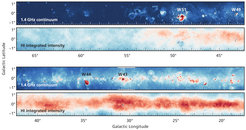Hot gas feeds spiral arms of the Milky Way
Magnetic fields point the way to the material that sustains star formation in the Milky Way
An international research team, with significant participation of astronomers from the Max Planck Institute for Astronomy (MPIA), has gained important insights into the origin of the material in the spiral arms of the Milky Way, from which new stars are ultimately formed. By analysing properties of the galactic magnetic field, they were able to show that the dilute so-called Warm Ionized Medium (WIM), in which the Milky Way is embedded, condenses near a spiral arm. While gradually cooling, it serves as a supply of the colder material of gas and dust that feeds star formation.

The Milky Way is a spiral galaxy, a disc-shaped island of stars in the cosmos, in which most bright and young stars cluster in spiral arms. There they form from the dense Interstellar Medium (ISM), which consists of gas (especially hydrogen) and dust (microscopic grains with high abundances of carbon and silicon). In order for new stars to form continuously, material must be constantly flushed into the spiral arms to replenish the supply of gas and dust.
A group of astronomers from the University of Calgary in Canada, the Max Planck Institute for Astronomy (MPIA) in Heidelberg and other research institutions have now been able to show that the supply comes from a much hotter component of the ISM, which usually envelops the entire Milky Way. This Warm Ionized Medium (WIM) has an average temperature of 10,000 degrees. High-energy radiation from hot stars causes the hydrogen gas of the WIM to be largely ionised. The results suggest that the WIM condenses in a narrow area near a spiral arm and gradually flows into it while cooling.

The scientists discovered the dense WIM by measuring the so-called Faraday rotation, an effect named after the English physicist Michael Faraday. This involves changing the orientation of linearly polarised radio emissions when they pass through a plasma (ionised gas) traversed by a magnetic field. One speaks of polarised radiation when the electric field oscillates in only one plane. Ordinary light is not polarised. The magnitude of the change in polarisation also depends on the observed wavelength.
In the present study, recently published in The Astrophysical Journal Letters, astronomers were able to detect an unusually strong signal in a rather inconspicuous area of the Milky Way, which is located directly on the side of the Sagittarius arm of the Milky Way facing the Galactic Centre. The spiral arm itself stands out in the imaging data due to strong radio emission generated by embedded hot stars and supernova remnants. However, the astronomers found the strongest shift in polarisation outside this prominent zone. They conclude from this that the increased Faraday rotation does not originate within this active part of the spiral arm. Instead, it originates from condensed WIM, which, like the magnetic field, belongs to a less obvious component of the spiral arm.

The analysis is based on the THOR survey (The HI/OH Recombination Line Survey of the Milky Way), which has been conducted at MPIA for several years now and in which a large area of the Milky Way is observed at several radio wavelengths. Polarised radio sources such as distant quasars or neutron stars serve as “probes” for determining the Faraday rotation. This allows astronomers not only to detect the otherwise difficult to measure magnetic fields in the Milky Way, but also to study the structure and properties of the hot gas. “We were very surprised by the strong signal in a rather quiet area of the Milky Way,” says Henrik Beuther from MPIA, who is leading the THOR project. “These results show us that there is still a lot to be discovered in studying the structure and dynamics of the Milky Way.”
Collaboration
This study was made possible by a cooperation of the following research institutions:
Department of Physics and Astronomy, The University of Calgary, Canada; Max Planck Institute for Astronomy, Heidelberg, Germany; Department of Physics and Astronomy, West Virginia University, USA; Green Bank Observatory, USA; Center for Gravitational Waves and Cosmology, West Virginia University, USA; Argelander Institute for Astronomy, University of Bonn, Germany; Centre for Astronomy, University of Heidelberg, Germany; Jet Propulsion Laboratory, California Institute of Technology, USA; Interdisciplinary Centre for Scientific Computing, University of Heidelberg, Germany; Research School of Astronomy and Astrophysics, The Australian National University, Canberra, Australia; Max Planck Institute for Radio Astronomy, Bonn, Germany; Jodrell Bank Centre for Astrophysics, The University of Manchester, United Kingdom


